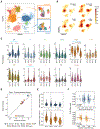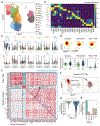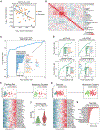Single-cell RNA-seq reveals cell type-specific molecular and genetic associations to lupus
- PMID: 35389781
- PMCID: PMC9297655
- DOI: 10.1126/science.abf1970
Single-cell RNA-seq reveals cell type-specific molecular and genetic associations to lupus
Erratum in
-
Erratum for the Research Article "Single-cell RNA-seq reveals cell type-specific molecular and genetic associations to lupus" by R. K. Perez et al.Science. 2024 Jul 12;385(6705):eadr4064. doi: 10.1126/science.adr4064. Epub 2024 Jul 11. Science. 2024. PMID: 38991087 No abstract available.
Abstract
Systemic lupus erythematosus (SLE) is a heterogeneous autoimmune disease. Knowledge of circulating immune cell types and states associated with SLE remains incomplete. We profiled more than 1.2 million peripheral blood mononuclear cells (162 cases, 99 controls) with multiplexed single-cell RNA sequencing (mux-seq). Cases exhibited elevated expression of type 1 interferon-stimulated genes (ISGs) in monocytes, reduction of naïve CD4+ T cells that correlated with monocyte ISG expression, and expansion of repertoire-restricted cytotoxic GZMH+ CD8+ T cells. Cell type-specific expression features predicted case-control status and stratified patients into two molecular subtypes. We integrated dense genotyping data to map cell type-specific cis-expression quantitative trait loci and to link SLE-associated variants to cell type-specific expression. These results demonstrate mux-seq as a systematic approach to characterize cellular composition, identify transcriptional signatures, and annotate genetic variants associated with SLE.
Figures






Comment in
-
Population genetics meets single-cell sequencing.Science. 2022 Apr 8;376(6589):134-135. doi: 10.1126/science.abq0426. Epub 2022 Apr 7. Science. 2022. PMID: 35389792
-
Single-cell RNA sequencing sheds light on cell-type specific gene expression in immune cells.Nat Rev Rheumatol. 2022 Jul;18(7):363. doi: 10.1038/s41584-022-00802-7. Nat Rev Rheumatol. 2022. PMID: 35689032 No abstract available.
References
MeSH terms
Substances
Grants and funding
- K24 AR074534/AR/NIAMS NIH HHS/United States
- R01 CA227237/CA/NCI NIH HHS/United States
- U01 HG012079/HG/NHGRI NIH HHS/United States
- R03 DE025665/DE/NIDCR NIH HHS/United States
- R01 GM142112/GM/NIGMS NIH HHS/United States
- R01 MH125252/MH/NIMH NIH HHS/United States
- R35 CA253175/CA/NCI NIH HHS/United States
- P30 AR070155/AR/NIAMS NIH HHS/United States
- R01 CA194511/CA/NCI NIH HHS/United States
- R01 AR071522/AR/NIAMS NIH HHS/United States
- U01 HG009080/HG/NHGRI NIH HHS/United States
- R01 CA223484/CA/NCI NIH HHS/United States
- U01DP005120/ACL/ACL HHS/United States
- U01 DP005120/DP/NCCDPHP CDC HHS/United States
- K25 HL121295/HL/NHLBI NIH HHS/United States
- U01 HG012192/HG/NHGRI NIH HHS/United States
- F31 HG011007/HG/NHGRI NIH HHS/United States
- HHMI/Howard Hughes Medical Institute/United States
- R01 HG006399/HG/NHGRI NIH HHS/United States
- T32 HG002536/HG/NHGRI NIH HHS/United States
- R01 HG011345/HG/NHGRI NIH HHS/United States
- R21 AI133337/AI/NIAID NIH HHS/United States
LinkOut - more resources
Full Text Sources
Other Literature Sources
Medical
Molecular Biology Databases
Research Materials

